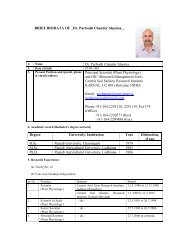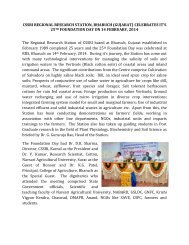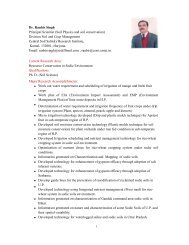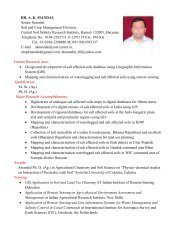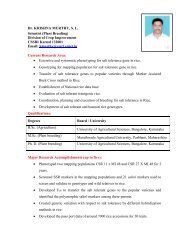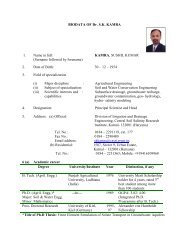CSSRI Annual Report 2010-11 - Central Soil Salinity Research ...
CSSRI Annual Report 2010-11 - Central Soil Salinity Research ...
CSSRI Annual Report 2010-11 - Central Soil Salinity Research ...
You also want an ePaper? Increase the reach of your titles
YUMPU automatically turns print PDFs into web optimized ePapers that Google loves.
<strong>CSSRI</strong> <strong>Annual</strong> <strong>Report</strong> <strong>2010</strong>-<strong>11</strong><br />
Reclamation and management of coastal saline soils<br />
Fresh water scarcity in the non-monsoon period<br />
is the major problem of the area. Shallow tube<br />
wells were installed since almost a decade and<br />
ground water was exploited for increasing the<br />
cropping intensity. The over exploitation of<br />
ground water has affected the functioning of<br />
the tube wells due to depletion of the water<br />
table and also deteriorated the water quality.<br />
Therefore, artificial recharge to fresh water<br />
aquifers is required.<br />
From the data collected from primary and<br />
secondary sources, it was found that some parts<br />
of South 24 Parganas districts are conducive for<br />
artificial recharge. Three villages in this district<br />
namely Andharia, Chandkhali and Bahirsona<br />
were surveyed regarding installation of shallow<br />
tube wells and utilization of groundwater.<br />
Mostly, the high water requiring crop i.e. paddy<br />
is cultivated utilizing the groundwater. The<br />
groundwater from the shallow tube wells were<br />
tested and found that the salinity increased in<br />
the summer. The fresh water aquifer, which is<br />
exploited by the shallow tube wells, was in the<br />
range 90-120 m and is of better quality than the<br />
shallow tube wells in the range 72-90 m. The<br />
diameter of the tube wells varied from 62.5 mm<br />
and 75 mm. The design of the filter chamber<br />
for artificial recharge to fresh water aquifers is<br />
given in Fig. 48.<br />
Fig. 48 : The design of the filter for artificial recharge<br />
through tube well<br />
Socio-economic Impact of Improved<br />
Technologies in the Coastal Areas of West<br />
Bengal (Subhasis Mandal, S.K. Sarangi, D.<br />
Burman and B.K. Bandyopadhyay)<br />
Coastal agriculture is commonly characterized<br />
by complex, risk prone and fragile ecosystem.<br />
Efforts are being made to improve the<br />
productivity of farming systems in the coastal<br />
region. This project envisaged to analyse the<br />
socio-economic impact of some key technologies<br />
or best management practices that are being<br />
tried under farmers’ field condition. The project<br />
was initiated during 2009-10 in coastal areas<br />
of Sundarbans (West Bengal). Site selection<br />
has been done and baseline information was<br />
collected from the adopters and non-adopters of<br />
improved technologies as promoted by <strong>CSSRI</strong>,<br />
RRS Canning Town. Major technologies targeted<br />
for socio-economic study are various land<br />
shaping technologies such as farm pond, ridge<br />
& furrow and paddy-cum-fish and adoption of<br />
improved rice varieties both in kharif and rabi<br />
season. The economics of dominating farming<br />
systems have been analysed and database on<br />
socio-economic condition of farmers are being<br />
analysed.<br />
The baseline information indicated that majority<br />
of farmers (85%) in the study area were belonging<br />
to weaker section of the society (primarily SC)<br />
and 94 percent of the farmers were marginal<br />
land-holders, rest were small-farmers (1.7 %) and<br />
landless (4.1 %). The land situation is primarily<br />
dominated by low lying (76%) followed by<br />
medium (15%) and upland (9%). Despite having<br />
low return, agriculture was the main occupation<br />
and nearly 42 per cent of the farm families were<br />
primarily dependent on agriculture. In absence<br />
of gainful livelihood options in the local area,<br />
migration to nearby cities is quite prevalent (32%<br />
of farm families) in the study area for search<br />
of alternative livelihood options. Cropping<br />
intensity in the study area was calculated to be<br />
quite low at 120-125 per cent and the cropping<br />
pattern was dominated by the kharif paddy.<br />
Major cropping systems prevailing in the study<br />
area were rice-fallow or rice-rice. The proposed<br />
technological interventions are envisaged to<br />
enhance the cropping intensity as well as farm<br />
income through creation of water resources by<br />
harvesting and storing of rainwater at farm level<br />
Majority of farmers (85%) in the study area<br />
belonged to weaker section of the society<br />
(primarily SC) and 94 percent of the farmers<br />
were marginal land holders, rest were<br />
small and landless. The land situation is<br />
primarily dominated by low-lying followed<br />
by medium and upland<br />
101





